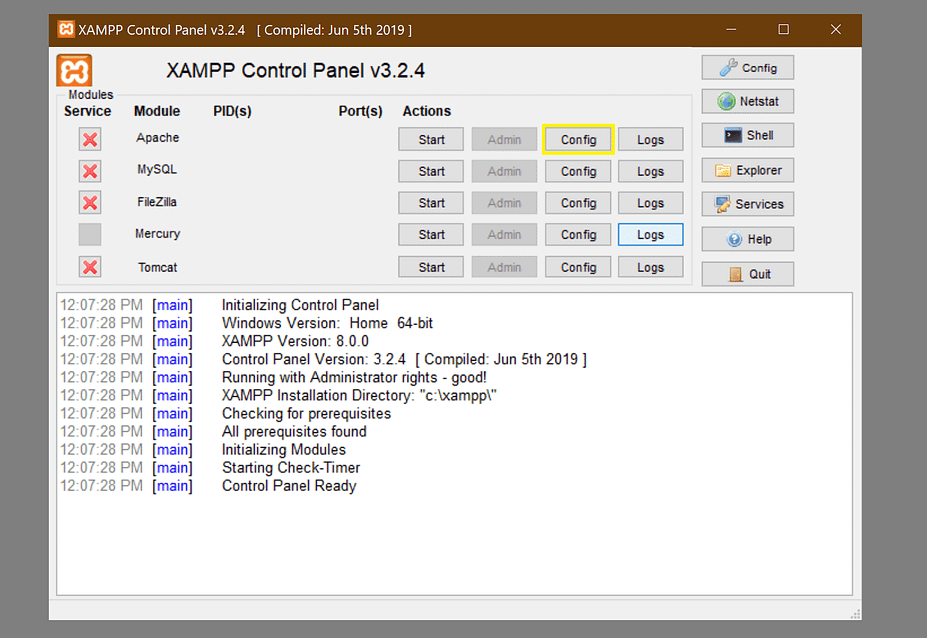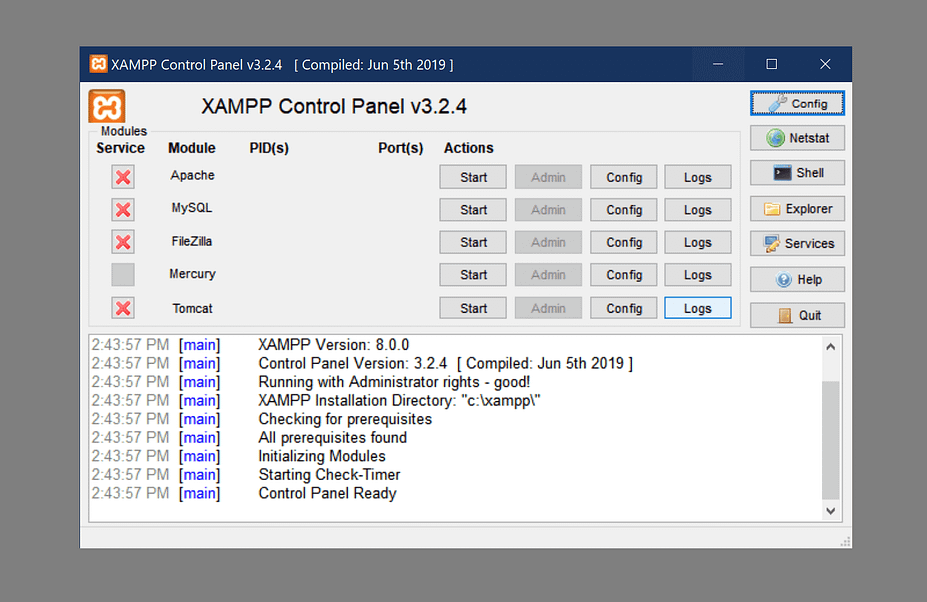Specialized mistakes are infrequently a welcome sight, particularly on the off chance that they interfere with your work process. In case you’re utilizing XAMPP for neighborhood improvement, you may have run into an especially befuddling message that peruses, “XAMPP blunder Apache Shutdown Unexpectedly”. Figuring out how to rapidly resolve this obscure issue so you can return to work can be baffling.
Luckily, investigating it isn’t unexpected quite basic. All you need is a word processor to reconfigure a couple of straightforward settings in your XAMPP documents. Shortly, you can take out this mistake and return to building your most recent task.
In this article, we’ll cover what the “XAMPP blunder Apache closure startlingly” message implies so you can all the more likely get it. Then, at that point, we’ll find you through three basic ways to fix the issue with devices that are probable as of now available to you. We should make a plunge!
What “XAMPP Error Apache Shutdown Unexpectedly” signifies
XAMPP is an incredible and well known advancement device. You can utilize it to assemble a site on a nearby worker. This is valuable for making new sites, just as testing out changes, refreshes, and new modules or subjects on existing sites.
Sadly, this doesn’t imply that XAMPP consistently works impeccably. In spite of being very much planned, there’s consistently a possibility that something will turn out badly. On account of the “XAMPP blunder Apache closure out of the blue” message, this issue can be especially disappointing.
This admonition seems when you attempt to boot up XAMPP. In addition, that is not generally the main mistake message you’ll see. You could likewise get some investigating data, for example, text like the accompanying:
Mistake: Apache closure suddenly. This might be because of an impeded port, missing conditions, inappropriate advantages, an accident, or a closure by another strategy. Check the “/xampp/apache/logs/error.log” record and the Windows Event Viewer for additional hints.
That is a great deal of data in a single message. Accordingly, it’s not difficult to become threatened by every one of the potential reasons for this issue. Besides, realizing how to decipher this load of subtleties can be significantly harder in case you’re not knowledgeable in the pertinent innovation.
Luckily, the root issue is regularly beautiful straightforward. This mistake message as a rule implies that there’s another program that is utilizing the very port that XAMPP does of course.
A port is an organization association point utilized by an assortment of projects. Each port just backings each program in turn. Along these lines, if another application is obstructing the port XAMPP ordinarily interfaces with, it will keep the stage from firing up.
Customarily, the guilty party in the present circumstance is Skype, as it utilizes a similar default port as XAMPP. In any case, it very well may be another program. Attempting to investigate precisely which application is causing the issue can be a cerebral pain. That is the reason we’ll be going directly to XAMPP’s documents to fix this issue.
Instructions to determine the “XAMPP Error Apache Shutdown Unexpectedly” message (in 3 stages)
On the off chance that you’ve never managed arrangement documents, relax. This interaction ought to be genuinely straightforward. Moreover, all you’ll require is your XAMPP establishment and a text or code editorial manager.
Stage 1: Launch the XAMPP Apache arrangement settings
In the first place, feel free to dispatch the XAMPP dashboard. The actual program doesn’t need to work. However long you can get to your dashboard, you ought to have the option to determine the blunder.
Furthermore, take a stab at running XAMPP as a chairman. You can do this by right-tapping on the program and choosing Run as head. This isn’t essential for this walkthrough, yet it can forestall intermittent disconnected mistakes.
Whenever you’ve dispatched XAMPP, explore to the column named Apache under the heading Module. Under Actions, select Config:

Note that when you see the “XAMPP mistake Apache closure startlingly” message, that implies that the issue is explicitly identified with Apache. Thusly, you’ll need to tap on that particular Config button to appropriately fix it. None of different columns in this window will work.
Tapping on the Config button will open a dropdown menu posting a couple of record names. Each addresses an arrangement record for the program. Pick the primary choice, named Apache (httpd.conf):

You can either open it with your default word processor, or a particular code supervisor. However long you can make changes to the document and save them, how you do as such doesn’t actually make any difference. We’ll utilize Notepad.
When you open the httpd.conf document, you’ll see some text like the accompanying:

Indeed, this can be a bit scaring in case you’re new to altering setup documents. Fortunately you’ll just have to alter a couple of straightforward things.
Notwithstanding, we do suggest that you tread carefully. Setup documents regularly convey data that is fundamental for a program’s typical activity. Accordingly, make an effort not to alter anything that you don’t comprehend. You may likewise need to save a reinforcement of this document before you continue to the following stage.
Stage 2: Change your default port settings in httpd.conf
As we previously referenced, when you see the “XAMPP blunder Apache closure surprisingly” message, it’s quite often an issue with an obstructed port. Accordingly, we’ll be changing the ports that the program regularly uses to interface with your organization.
Except if you’ve transformed it previously, the default port for Apache is 80. Port 80 is explicitly for HTTP programs. Be that as it may, it’s not simply the default for Apache. Numerous different projects will utilize port 80 also, which can prompt contentions on the off chance that you attempt to run various projects on this port without a moment’s delay.
To settle this issue, you need to divert Apache to port 8080. This is an other HTTP-explicit port. All things considered, XAMPP will keep on functioning as should be expected, however with less probability that its port will become hindered again later on. Accordingly, this is additionally a safeguard measure against future port struggle mistakes.
How about we return to the design document. Press Ctrl + F to open an inquiry exchange. Enter 80 into the field to discover each occurrence of the number in the document:

There will presumably be a modest bunch of occurrences where 80occurs. Notwithstanding, you just need to change a couple of them. In particular, you’ll need to change three things:
Change Port 80 to Port 8080
Change Listen 80 to Listen 8080
Change servername localhost: 80 to servername localhost: 8080
By and by, we urge you to just change these three things. Not exclusively will adjusting inconsequential lines not address this blunder, yet it could likewise cause another. In the event that you incidentally alter some unacceptable component, you can reestablish your own reinforcement or discover the default Apache document on Github.
Save the httpd.conf record and close it when you’re done rolling out these improvements. Then, at that point return to your XAMPP control board for the last advance.
Stage 3: Update your default port settings in http-ssl.conf
In conclusion, we’ll be altering one last arrangement document. To get to it, rehash the directions from Step 1. Go to the Apache line under Module and select Config. In any case, this time, click on the subsequent choice in the dropdown menu, named Apache (httpd-ssl.conf):

Open up the text document in your favored proofreader. Be that as it may, this time you will not be looking for 80. All things being equal, hit Ctrl + F and quest for the number 443.
Port 443 is the port that is normally utilized for secure web exchanges. Be that as it may, Apache additionally needs it. In this way, you need to change two occurrences of 443 to the elective port – 4433:
Change Listen 443 to Listen 4433
Change to
Make certain to save your work in this document too. Whenever you’re done, close your text or code editorial manager. Furthermore, shut down XAMPP and relaunch it. This will reset the cycles so Apache can utilize the new substitute ports you’ve determined.
Upon the reset, everything should work typically. Your control board should look something like this:

From here, you ought to have the option to tap on Start close to Apache and proceed with your work on your nearby site. Recall to not utilize ports 8080 or 4433 for some other projects, or you might need to rehash this interaction.
Whenever you have settled this blunder, you might need to explore different projects to see which one is taking up Apache’s default ports. On the off chance that you choose to change one more program’s settings to disengage it, you can rehash these means to reconnect XAMPP to ports 80 and 443.
End
Investigating a blunder when you’re in an advancement project is irritating and gobbles up important time. Apache mistakes specifically can be irritating. Luckily, by adjusting a couple of design documents, you can rapidly resolve this disappointing detour.
In this article, we covered three simple tasks to determine the “XAMPP mistake Apache closure startlingly” message:
Dispatch the Apache setup settings from the XAMPP dashboard.
Open the httpd.conf record and change the default port from 80 to 8080.
Open the http-ssl.conf record and change the default port from 443 to 4433.
At long last, on the off chance that you consistently have issues with XAMPP, there are heaps of other nearby advancement instruments that you can consider, like DesktopServer, Docker, or Vagrant.
Do you have any inquiries regarding settling the “XAMPP blunder Apache closure suddenly” message? Tell us in the remarks segment beneath!
